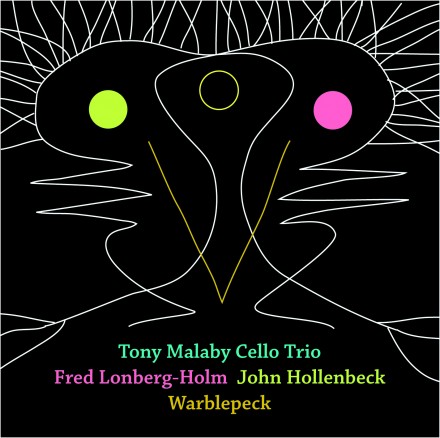Tony Malaby Cello Trio
Warblepeck
SGL SA1574-2“…[It’s] all about creating on the spot and flying without a map…The music of Warblepeck was created in the moment, but it will be remembered, and played, for a long, long time.”
– Steve Greenlee, Jazz Times
In the five years since his previous release on Songlines (Apparitions, with Drew Gress, Tom Rainey and Michael Sarin), Tony Malaby has reconfirmed his position as one of New York’s most versatile and distinctive jazzmen. Whether as leader of several groups, or sideman with Mark Helias, Fred Hersch, Paul Motian and Charlie Haden among others, Malaby combines a broad and generous mastery of the whole jazz tradition with a true pathfinder’s spirit. In his Cello Trio he engages with two like-minded sonic explorers, the omni-dextrous New York drummer/percussionist John Hollenbeck and the genre-hopping Chicago cellist Fred Lonberg-Holm, to create highly integrated, multi-faceted avant-jazz.
As members of the NY jazz elite, Hollenbeck and Malaby had often played together in different contexts, but neither had been in a group with Lonberg-Holm, whose studies with Morton Feldman and background in rock, noise, electronics, and the Chicago improv scene provided a refreshing stimulus to Tony: “I wanted to play with an instrument I really hadn’t improvised with a lot before, and I was also looking for somebody who could function in the bass role and who was going to bring a different kind of buoyancy to the feeling with the time and rhythm.”
Another aim was to work with pieces by other composers as well as his own, “pieces that delegate different responsibilities” to the players. “My compositions are really simple, so it’s just a matter of playing together, creating a relationship and learning, for example, how Fred interprets a written structure when John and I are improvising against that. Bill Frisell’s little-known “Waiting Inside” is one of Tony’s favorite ‘brooders,’ “and a really cool set of responsibilities: those chord changes played by John on melodica, and it has a unique structure.” There’s very little discussion though, so as not to lock down the process and hinder the way things can develop: “It’s a commitment to really deep listening, being plugged into what’s going on around me more than what’s coming out of the horn, and just reacting in an automatic way, and that’s what John and Fred are doing too.”
The music’s richness also has a lot to do with Tony’s interest in painting, photography and film, and the way he draws on these artforms to think graphically and texturally, visualizing new musical structures through juxtaposing images, colors, and forms: “I’m always thinking that way, trying to get out of the jazz tenor headspace. For example, ‘Warblepeck’ – I’m trying to scribble and pick and be poitillistic with some of the timbres I use, at the same time drawing from nature, bird sounds, trying to get to a really primal space….In the last three or four years I’ve been exposed to the films of Stan Brakhage, and that’s been a really big source of inspiration: how to transfer that to sound. Also paintings by Cy Twombley, Pierre Alechinsky, Mexican folk art, and classic film noir, and silent films, Buster Keaton. I draw from these elements in ways that really affect rhythm and pacing, not just the sonic and textural universe. I try to draw on the rhythm and pace involved in good storytelling.” Asked if he feels his music expresses a particular world-view, Tony replies: “I think mystery, allowing people to hear the process and not being afraid of that – everything in jazz these days is so athletic and picture-perfect. I like creating and listening to music where you can really hear people engaged in the mystery of creation and process. We’re having such a blast and really surrendering to that, and not caught up in perfection.”
Throughout, Malaby’s unmistakable blustery tenor and gorgeous, piercing soprano are constantly offset and complemented by Lonberg-Holm’s cello tactics and looping and Hollenbeck’s highly melodic percussive layering. This music combines freedom and discipline, openness and density, beauty and harshness, humor and seriousness in very personal ways. The audiophile recording and especially the multi-channel mix effectively transmit its expressive depth and audacity.
Further info: lonberg-holm.info, johnhollenbeck.com.

